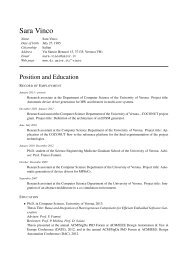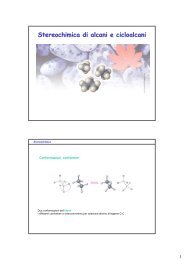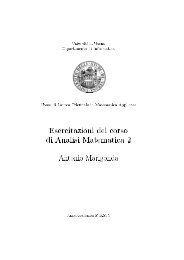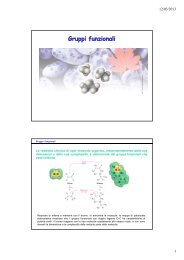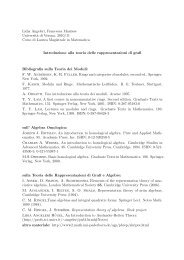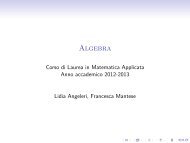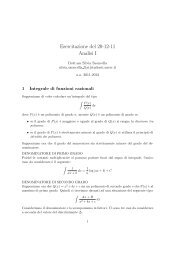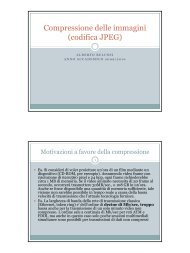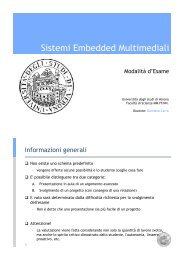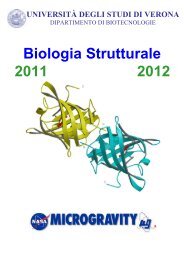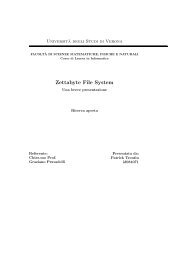You also want an ePaper? Increase the reach of your titles
YUMPU automatically turns print PDFs into web optimized ePapers that Google loves.
146 28. METODO DI SEPARAZIONE DELLE VARIABILI - CONTINUAZIONE<br />
dove si è posto an = U(0)c1, quindi an ∈ R \ {0}. Cerchiamo di raggiungere il dato iniziale con una serie di<br />
queste soluzioni:<br />
∞<br />
∞<br />
u(0, x) = 2x = un(0, x) = a0 + cos (nx) ,<br />
j=0<br />
quindi i coefficienti an sono i coefficienti dello sviluppo in serie di Fourier di soli coseni della funzione f(x) = 2x,<br />
mentre a0 è il doppio del coefficiente di ordine 0 dello sviluppo in serie di Fourier di f. Prolunghiamo quindi f<br />
per par<strong>it</strong>à a tutto [−π, π] e poi per 2π-periodic<strong>it</strong>à a tutto R. Si ha:<br />
a0 = 1<br />
π<br />
an = 2<br />
π<br />
π<br />
0<br />
π<br />
0<br />
n=1<br />
2x dx = π<br />
2x cos nx dx = 4<br />
π sin nx<br />
x −<br />
π n 0<br />
4<br />
nπ<br />
π<br />
0<br />
sin(nx) dx<br />
= 4<br />
n2π [cos(nx)]π0 = 4 (−1)n − 1<br />
n2π Quindi a0 = π, a2k = 0 e a2k−1 = −8/(π(2k − 1) 2 ) per k ∈ N, k ≥ 1. La soluzione risulta quindi:<br />
u(t, x) = π − 8<br />
π2 ∞ e−5(2k−1)2 <br />
t cos (2k − 1)x<br />
(2k − 1) 2 .<br />
La serie converge totalmente quindi uniformemente, infatti si ha:<br />
∞<br />
<br />
<br />
e<br />
sup <br />
<br />
−5(2k−1)2 <br />
t cos (2k − 1)x<br />
(2k − 1) 2<br />
<br />
<br />
<br />
<br />
≤<br />
∞ 1<br />
< +∞,<br />
(2k − 1) 2<br />
k=1<br />
k=1<br />
(ad esempio per confronto con la serie di termine generale 1/k 2 ).<br />
Esercizio 28.2. Si determini col metodo di separazione delle variabili la soluzione (sotto forma di serie)<br />
dell’equazione alle derivate parziali:<br />
⎧<br />
−ut + 2uxx + 3ux + u = 0, per t > 0, x ∈]0, π[,<br />
⎪⎨<br />
u(0, t) = u(π, t) = 0,<br />
⎪⎩<br />
3 −<br />
u(x, 0) = e 4 x π<br />
2 −<br />
<br />
<br />
x − π<br />
<br />
<br />
,<br />
2<br />
Si discuta la convergenza uniforme della serie ottenuta.<br />
Svolgimento. Cerchiamo soluzioni non nulle nella forma u(x, t) = U(t)X(x), sost<strong>it</strong>uendo si ottiene<br />
k=1<br />
− ˙ U(t)X(x) + 2U(t) ¨ X(x) + 3U(t) ˙ X(x) + U(t)X(x) = 0<br />
e dividendo per U(t)X(x) si ha:<br />
− ˙ U(t) + U(t)<br />
= −<br />
U(t)<br />
2 ¨ X(x) + 3 ˙ X(x)<br />
X(x)<br />
Si ottengono quindi le due equazioni (λ ∈ R):<br />
<br />
− ˙ U(t) + (1 − λ)U(t) = 0,<br />
2 ¨ X(x) + 3 ˙ X(x) + λX(x) = 0.<br />
al variare di λ ∈ R. Studiamo l’equazione per X(x), la sua equazione caratteristica al variare di λ ∈ R è<br />
2µ 2 +3µ+λ = 0, il cui discriminante è ∆ = 9−8λ. Dalle condizioni al contorno, si ricava u(0, t) = U(t)X(0) = 0<br />
per ogni t e u(π, t) = U(t)X(π) = 0 per ogni t, il che implica X(0) = X(π) = 0.<br />
Se ∆ > 0, l’equazione caratteristica ammette le radici reali distinte λ1 e λ2, e l’equazione per X(x) ammette<br />
come soluzione generale X(x) = c1e λ1x + c2e λ2x . Sost<strong>it</strong>uendo, si ottiene 0 = c1 + c2 dalla prima e quindi<br />
X(x) = c1(e λ1x − e λ2x ). Sost<strong>it</strong>uendo X(π) = 0, si ha 0 = c1(e λ1π − e λ2π ), ed essendo λ1 = λ2, si ottiene<br />
c1 = c2 = 0, soluzione non accettabile.<br />
Se ∆ = 0, l’equazione caratteristica ammette la radice reale doppia λ1, e l’equazione per X(x) ammette come<br />
soluzione generale X(x) = c1e λ1x + c2xe λ1x . Sost<strong>it</strong>uendo le condizioni al contorno si ha c1 = 0 e 0 = c2πe λ1π ,<br />
il che implica c2 = 0 e anche questa soluzione non è accettabile. Supponiamo ∆ < 0, in tal caso l’equazione<br />
caratteristica ammette le radici complesse coniugate λ1 = α+iω e λ2 = α−iω dove α = −3/4 e ω = |∆|/4 = 0.



